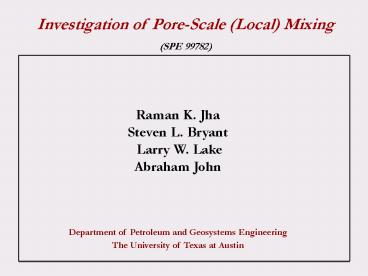Hypothesis 1: no porescale mixing - PowerPoint PPT Presentation
1 / 25
Title:
Hypothesis 1: no porescale mixing
Description:
Qualitatively similar to experimental conditions. Simulations on an Ordered Pack ... Simulations on a Disordered Pack. Max: 1. Min: 0. t = 0 sec. t = 60 sec ... – PowerPoint PPT presentation
Number of Views:18
Avg rating:3.0/5.0
Title: Hypothesis 1: no porescale mixing
1
Investigation of Pore-Scale (Local) Mixing (SPE
99782)
Raman K. Jha Steven L. Bryant Larry W.
Lake Abraham John Department of Petroleum and
Geosystems Engineering The University of Texas at
Austin
2
Role of Mixing in Porous Media
- Dilutes the injected solvent slug and reduces its
displacement efficiency - Understanding mixing important for
- determining the effectiveness of miscible floods
- better design and control of miscible flood
processes
3
Mechanisms of Mixing in Porous Media
- A complex process involving an interplay of
- Mechanical Mixing
- velocity differences within pores
- path differences
- Molecular Diffusion
- random movement of solute molecules
4
Conventional Quantification of Mixing
- Flow averaged concentration histories measured in
laboratories - Core-scale mixing termed as dispersion used to
quantify mixing - No information about origin of core scale mixing
5
Hypotheses for Solute Mixing
Hypothesis 1 Streamline Flow Hypothesis
- No interaction among solute particles on
different streamlines - Core scale mixing an artifact of particle
residence time distribution
6
Hypotheses for Solute Mixing
Hypothesis 2 Local Mixing Hypothesis
- Streamline flow with random jump of particles to
neighboring streamlines - Core scale mixing a result of local mixing
7
Approach
- Measure local solute concentration history using
a thin probe - Investigate mixing mechanism by solving Navier
Stokes and convection diffusion equations in pore
space
8
Experimental Studies
- Standard tracer step change experiments in a sand
column - Overall (cup-mixing) concentration history
obtained - A thin electrical conductivity probe developed to
measure local solute concentration - Local solute concentration history measured at
several radial and axial positions
9
Experimental Measurements
- Gradual rise in local solute concentration
- Local mixing same as core scale mixing
10
Experimental Measurements
- Mixing zone grows with distance traveled
- Local mixing same as core scale mixing
- Local mixing hypothesis valid
11
Discussion on Experimental Results
Mixing Cell Theory
If diffusion to
equalizes concentration within each pore For our
experiments
Complete local mixing because of molecular
diffusion
12
Computational Studies
- To corroborate experimental observations
- To understand mixing mechanism over a wider range
of flow conditions - Navier-Stokes and convection-diffusion equations
solved in surrogate pore space to simulate
miscible flow - Simulations carried out for a range of flow
velocities and diffusion coefficients
13
Simulations on an Ordered Pack
- Fluid injected at inlet face at
- Outlet face at atmospheric pressure
- Navier-Stokes equation solved to obtain steady
state velocity profile
14
Simulations on an Ordered Pack
- Concentration profile obtained by solving
convection-diffusion equation
15
Simulations on an Ordered Pack
Qualitatively similar to experimental conditions
16
Simulations on an Ordered Pack
- Diffusion enhances mixing
17
Simulations on an Ordered Pack
For homogeneous media local and overall mixing
are same for complete local mixing
18
Simulations on a Disordered Pack
Wide variation in local velocity
19
Simulations on a Disordered Pack
20
Simulations on a Disordered Pack
Local Mixing differs with position in
heterogeneous medium
21
Simulations on a Disordered Pack
Diffusion enhances local mixing and reduces
effect of local heterogeneity on solute transport
22
Simulations on a Disordered Pack
For diffusion dominated process all the local and
overall curves collapse into one
23
Simulation of Slug Injection Process
Incomplete mixing inside the pore body at higher
24
Conclusions
- Evidence of non-zero local mixing in experiments
- Mixing a result of velocity variations within the
pores and molecular diffusion - The converging-diverging flow around sand grains
causes the solute front to stretch, split and
rejoin
25
Conclusions
- Diffusion tends to reduce radial variation in
solute concentration - For slow fluid velocity diffusion is able to
homogenize solute concentration inside each pore - In limit of very high fluid velocity (or no
diffusion) local mixing tends to zero































